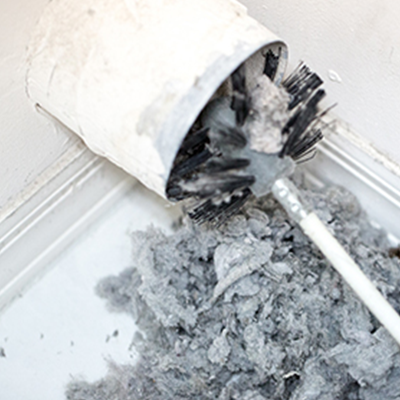No Products in the Cart

Most of us don’t think a lot about our dryers. It’s a machine that serves the purpose of drying our laundry, day after day. Have you ever thought where all the lint build up actually goes beyond the vent? We clean out the lint trap and think that’s enough. But it’s not! Your lint is like a ticking time bomb. Many people feel no need to worry about lint because they Clean Their Filter after every drying cycle.
Clothes dryers evaporate the water from wet clothing by blowing hot air past them while they tumble inside a spinning drum. Heat is provided by an electrical heating element or gas burner. Some heavy garment loads can contain more than a gallon of water that will become airborne water vapor and leave the dryer and home through an exhaust duct, more commonly known as the dryer vent.

The removable lint filter in your dryer simply cannot catch all the lint freed from clothing. The lint that makes it past the filter gets trapped in crevices deep inside the lint filter trap and all along the dryer ductwork as it makes its way to the outside vent opening. If those vents are clogged you put your home in a dangerous situation. When the lint builds up, they restrict airflow and lead to overheating, which can ignite the lint itself. Ultimately, this can cause your dryer to catch on fire.
What are the warning signs that dangerous lint buildup is occurring in your dryer and venting system? Symptoms may include:
To clean the lint trap, first, remove the lint trap filter from the dryer and clean it. This must be done before or after each use of the dryer. Also, vacuum the lint trap housing cavity monthly.

Vacuum the inside of the lint trap housing, using a long, skinny hose attachment for your vacuum cleaner. Follow the initial vacuuming with a second pass, using the long flexible brush from the brush kit. Extend the brush all the way into the bottom of the cavity, then gently pull the brush out of the dryer housing.

Clean the brush bristles with the vacuum. Repeat as needed until there is no more lint that can be removed from the cavity.
Experts recommend cleaning the lint filter after every use and conducting thorough routine clean once a year. You can fork over $100 to $150 to a pro or if you’re a do-it-yourselfer, grab a vent cleaning kit and vacuum with a long hose and get to work. Here’s why:
AVOID A FIRE
A clogged dryer often leads to electrical issues that can ignite a fire. In fact, according to the U.S. Fire Administration, 2,900 fires in home dryers are reported each year and cause about five deaths, 100 injuries and $35 million in property loss.
IMPROVE AIR FLOW
Restricting a dryer’s air flow leads to more energy usage and slows down the machine. Best way to fix this? In addition to regular cleaning and lint removal, make sure your dryer sits level to ensure clothes tumble properly.
AVOID EXPENSES
The average repair cost for a faulty dryer ranges from $50 to $1,000, according to HomeAdvisor.com. Also, blocked vents cause dryers to work harder and use more electricity, which equates to higher utility bills. Properly maintaining your appliance to keep the repairman away and save money in the long run.
KEEP HOUSE CLEAN
That debris not only piles up behind the dryer, it accumulates in the duct and vent pipe and heads outside as well. So be sure to disconnect each part and thoroughly clean with a brush or vacuum inside and out.